|
|
|
PRODUCTS MANUFACTURED BY:
|
|
|
|
|
|
|
|
|
|
|
 |
|
| Hanwei Practical Bastard Sword (SH2428) |
Points: 10

|
By customer request we have produced a re-enactment version of our SH2250 Bastard sword. The blade is forged in 5160 high-carbon steel, to minimize burring, and the transverse thickness of the guard has been increased, both to provide adequate strength for re-enactment use and to present a safer profile at the ends of the guard.
Sold Out
|
|
|
|
|
|
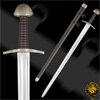 |
|
| Hanwei Practical Norman (SH2326) |
Points: 8
|
An important addition to our European practical line is the Practical Norman sword, based on a classic 11th century pattern popular during the Norman Invasion of Britain. The high-carbon deeply-fullered blade is light and well-balanced, with the wide edges required by the re-enactment community. The guard is wider than that of the earlier Viking designs that preceded this pattern and the pommel is of the "tea-cosy" type The grip is grooved and leather-wrapped and the scabbard is left plain for owner decoration.
Sold Out
|
|
|
|
|
|
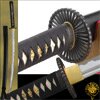 |
|
| Hanwei Practical Plus Iaito |
Points: 17
|
The Practical Plus Iaito provides an economical yet authentic sword for the Iaido practitioner. Available in 3 blade lengths (27, 28, 29) to perfectly match your needs. The blade is unedged for safety and forged from steel for more precise weight and balance than an aluminum blade can offer. The blade is also maintenance free, providing a lifetime of practice without worry of rust or tarnish. The Practical Plus features genuine Same (Rayskin) on the Tsuka, with a tightly-woven cotton wrap (Tsuka-Ito). The long tang is double-pegged for security. The fittings of the Practical Plus are decorated in a Japanese Dogwood motif with lion dog menuki, and the handsome Tsuba is of an iron
"sunburst" design with a brass habaki.
Sold Out
|
|
|
|
|
|
 |
|
| Hanwei Practical Plus Tanto (SH2259) |
Points: 8

|
The Practical Plus Tanto (SH2259) provides a very economical cutting tanto, but uses more traditional fittings and construction methods. The blade is hand-forged high-carbon steel and differentially tempered using a traditional claying method (HRC 60 edge, HRC 40 spine) with a medium (chu) kissaki. The temper line (hamon) is evident and prominent. The Practical Plus Tanto uses a flat black saya and a black Japanese cotton sageo. The tsuka has genuine ray skin (same) and the tsuka-ito is black synthetic leather for better gripping qualities. The antiqued fittings on this set are decorated in a Japanese dogwood motif with a beautiful antiqued black sunburst tsuba. A great econimcal tanto with fantastic quality.
High Carbon Blade
Authentic Design
Sold Out
|
|
|
|
|
|
 |
|
| Hanwei Practical Tai Chi Sword |
Points: 5

|
Practical Tai Chi Sword
The Practical Tai-Chi swords from Hanwei has been developed in response to many requests for a quality Tai-Chi sword for everyday practice. The SH2008 series features three blade lengths, to suit the individual requirements of the Tai-Chi practitioner. The SH2008A has a blade length of 28", SH2008B has a blade length of 30" and SH2008C has a blade length of 32". All models feature steel guards and pommels, plated to harmonize the color scheme of the sword. The blades are fully tempered high-carbon steel with a flattened-diamond blade section. A tassel (Item SH2078) is available separately.
Designed for T'ai Chi practitioners
Fully tempered high-carbon steel blade
Scabbard included
Sold Out
|
|
|
|
|
|
 |
|
| Hanwei Practical Tanto (SH2254) |
Points: 5

|
The Practical Series (SH1070, SH2061, & SH2254) represent our most popular set, offering excellent quality at a great price. The blades are hand-forged high-carbon steel and are differentially tempered using a traditional claying method to produce a HRC60 on the edge (ha) and a HRC40 on the back (mune) with a medium (chu) kissaki. The temper line (hamon) is authentic and prominent. The fittings (koshirae) are superbly antiqued adding to the aesthetics of the set. The saya is done in a deep black lacquer and the sageo is black Japanese cotton.
Hand-forged high-carbon steel
Differentially tempered
Deep black lacquered saya
Sold Out
|
|
|
|
|
|
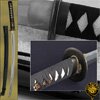 |
|
| Hanwei Practical XL Light Katana - 28,5 inch (SH6000LPF) |
Points: 18

|
The blade is forged and differentially tempered, using the same process as the more expensive blades and producing an HRC60 edge and HRC40 back. The temper line is authentic and prominent. Cost savings are effected by using fittings which, while making no claims to authenticity, are very strongly built to withstand the rigors of cutting exercises in the dojo.
Forged high-carbon steel blade
Differential tempering
Hanwei made
Sold Out
|
|
|
|
|
|
 |
|
| Hanwei Praying Mantis Katana (SH2359) |
Points: 55

|
The Praying Mantis is a symbol of cunning and power in Japanese culture and is consequently a highly respected theme in Samurai swords. Built on our new L6/Bainite blade (detailed below) in the Shobu Zukuri style with Bo-Hi, and featuring superb koshirae, the Praying Mantis is a very desirable and functional piece. The subdued green silk ito and deep brown of the lacquered saya provide handsome contrast to the dark copper and golden accents of the tsuba, fuchi and kashira. The stalking mantis lies in wait for his next prey, mirroring the power and grace in this exceptional katana.
Sold Out
|
|
|
|
|
|
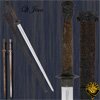 |
|
| Hanwei Qi Jian (SH2295) |
Points: 40
|
From the master swordsmiths of the Hanwei forge comes the Qi Jian, a re-creation of an ancient design that utilized one-piece forging. The entire sword, from pommel to tip, has been forged from a single billet of steel. This forging technique provides unparalleled strength and balance while exhibiting a clear, bell-like tone when lightly struck.
The sword's name originates with the Qi nation, one of the many warring states that eventually formed modern China. Legend has it that Feng-Xuan, one of the Qi people and a central character in a well known folk tale, possessed such a one piece sword and would use its ringing quality to accompany his singing.
The sword's grip is rayskin wrapped, a feature matched by the wrap on the throat of the scabbard, making for a stunningly beautiful presentation.
Sold Out
|
|
|
|
|
|
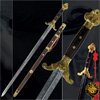 |
|
| Hanwei Qing Sword (SH2007) |
Points: 65
|
The traditional perception of the Taiji sword becomes very apparent in the Qing Sword. The last of the Chinese Dynasties, the Qing (Ching) Dynasty was overthrown by rebellion as late as 1911, by which time the Taiji sword had completed its evolution into the "modern" form. The sword is crafted around a beautifully pattern-welded K120C blade with a flattened diamond section. The guard and pommel are constructed of gilded steel featuring a flying bat design, which in Chinese ideology symbolizes luck. The scabbard decorations are in gilded brass and the intricate knot-work of the tassel is art in its own right.
Recreated by the craftsmen of CAS Hanwei from the swords of the Lords of the great dynasties, these Chinese Gongfu swords represent the pinnacle of the sword maker's art, vividly illustrating the skills and creativity of the smiths of Imperial China.
Sold Out
|
|
|
|
|
|
 |
|
| Hanwei Raptor Katana, Moroha Zukuri (SH2413) |
Points: 30


|
Forged in the Kissaki Moro Ha Zukuri style, the blade design of the Moroha Zukuri Katana is based on a Tachi blade believed to have been forged around 800 AD by the smith Amakuni, though many similar blades have been produced in later Japanese history.
Sold Out
|
|
|
|
|
|
 |
|
| Hanwei Raptor Katana, Nambokucho Zukuri (SH2416) |
Points: 30

|
The Nanbochuko period in Japanese history (the later part of the 14th. century) encompassed sixty years of internal conflict in Japan, which spawned a demand for more and bigger sword blades than ever produced previously.
Sold Out
|
|
|
|
|
|
 |
|
| Hanwei Raptor Unokubi Zukuri Katana (SH2415) |
Points: 15

|
The Raptor Unokubi-Zukuri (Cormorants Neck) blade design is patterned after the shape of the Naginata, the powerful long-handled weapon popular between the 12th and 14th centuries. Notable for the strongly relieved shinogi-ji and diamond-shaped kissaki, the Unokubi-Zukuri provides excellent balance in a strong cutting blade.
The blade of the Raptor katana is hand forged in 5160 high carbon steel and is specifically heat treated to produce very high resilience and greater tolerance to misdirected cuts than a conventionally differentially tempered blade.
The blade geometry is configured to facilitate the cutting of both soft and semi hard materials without chipping, allowing the user a wider range of targets.
Cotton wrapped tsuka.
Tsuba, fuchi and kashira features a beautiful Raptor motif.
Black matte finish wood saya.
Comes with black sword bag.
Sold Out
|
|
|
|
|
|
|
Tags:
martial arts, katana, iaito, sword, fencing, tonfa, boken, bokken, kama, shinai, samuraj, judo, karate, kenjutsu, kenjitsu, ninja, kungfu,
|










